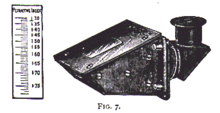Herbert Smith (mineralogist)
[6] In his mineralogical career, Smith worked on topics including the determination of mineral structures and compositions.
[8] Smith also developed new instruments for the practical measurement of the crystallographic and optical features of minerals and gems (goniometers and a refractometer),[4] and wrote a text book on gemstones and gemmology that was first published in 1912,[9][10] and went through many editions, with the thirteenth edition published posthumously after revisions by F.C.
[14][6] Smith provided pieces of smoked glass for viewing, and wrote a guide to the eclipse.
Richmond was in the line of totality, and many thousands of visitors attended on fleets of special excursion trains that day, including Virginia Woolf, who described the events in her diary and in a 1928 essay The Sun and the Fish.
[6] In 1918, Smith helped to establish the Society of Civil Servants 'to cover the middle and upper grades of the service'.
[13] Smith played a major role in the professional work of gemmologists in the United Kingdom.
[21] In 1926, Herbert's rock-wallaby, Petrogale herberti was named in Smith's honour, to reflect the assistance he had provided to Hubert Wilkins, on whose expedition the wallaby had been discovered.
